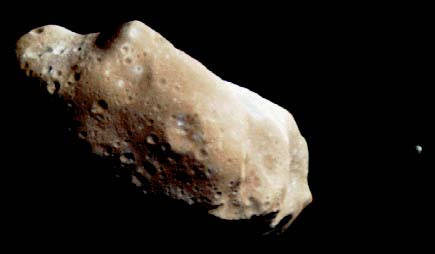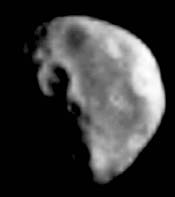Ida and Moon
Ida is an asteroid which became much more familiar with its close encounter with the planetary explorer spacecraft Galileo. In 1993, Galileo's rendevous with Ida brought the surprise discovery that Ida had its own satellite: a tiny moon about 1.5 km in diameter orbiting at a distance of about 90 km. The moon was named Dactyl.

This color picture is made from images taken by the imaging system on the Galileo spacecraft about 14 minutes before its closest approach to Ida on August 28, 1993. The range from the spacecraft was about 10,500 km. The images are from the sequence in which Ida's moon was originally discovered. The maximum dimension of Ida is about 60 km.
This picture is made from images through the 410 nm (violet), 756 nm (infrared) and 968 nm (infrared) filters. The color is enhanced in the sense that the camera is sensitive to near-infrared wavelengths of light beyone human vision; a natural color picture of this asteroid would appear mostly gray. Shadings in this image indicate changes in illumination angle on the many steep slopes of this irregular body as well as subtle color variations due to differences in the physical state and composition of the soil (regolith).
There are brighter areas, appearing bluish in the picture, around the small bright crater near the center of the asteroid, and near the upper righthand limb. This is a combination of more reflected blue light and greater absorption of near infrared light, suggesting a difference in the abundance of iron-bearing minerals in these areas.
From the analysis of the binary orbit of the moon Dactyl around Ida, Petit* determined the mass of Ida to be about 2.2 x 10-14 solar masses or 4.3 x 1016 kg and its density to be 2.7 +/- .4 g/cm3.
*Petit, J.-M., Durda, D.D., Greenberg, R., Hurford, T.A., & Geissler, P.E. 1997, The Long-Term Dynamics of Dactyl's Orbit, Icarus,139, 177-197Sources
| Closer images |
Solar System Illustration
Solar System Concepts
| HyperPhysics********** Astrophysics | R Nave |

